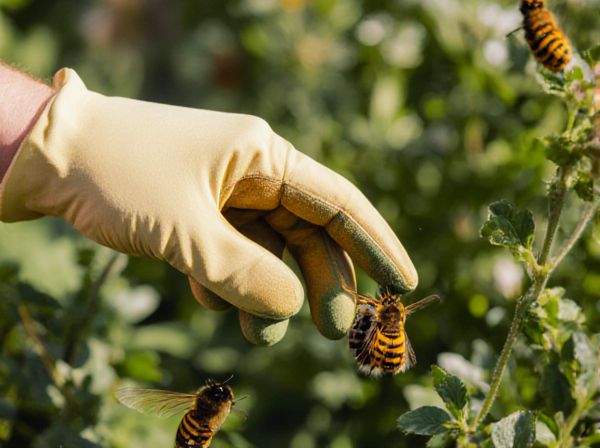
nectar robbing vs legitimate pollination Illustration
Nectar robbing occurs when insects extract nectar from flowers without contacting reproductive parts, thereby bypassing pollination and potentially harming plant reproduction. Legitimate pollination involves pollinators such as bees or butterflies that transfer pollen while foraging for nectar, promoting fertilization and seed production. Understanding the balance between nectar robbing and legitimate pollination is crucial for maintaining healthy ecosystems and crop yields.
Table of Comparison
| Aspect | Nectar Robbing | Legitimate Pollination |
|---|---|---|
| Definition | Extraction of nectar without pollination | Nectar collection with pollen transfer |
| Pollinator Type | Robbers (e.g., some bees, birds) | Effective Pollinators (e.g., bees, butterflies, hummingbirds) |
| Impact on Plant | Potentially negative or neutral | Positive, promotes reproduction |
| Floral Damage | Common, holes or tears in flowers | Minimal to none |
| Pollen Transfer | Absent or minimal | Significant and effective |
| Ecological Role | Can affect pollination dynamics | Crucial for ecosystem health |
| Example Species | Carpenter bees, flower piercers | Honeybees, bumblebees, hummingbirds |
Understanding Nectar Robbing in Pollinator Gardens
Nectar robbing occurs when insects or birds extract nectar from flowers without pollinating them, often by piercing the flower's base instead of entering through the reproductive structures. This behavior impacts pollinator gardens by reducing the availability of nectar for legitimate pollinators like bees and butterflies, which are essential for effective pollination and plant reproduction. Understanding nectar robbing helps garden designers select plant species with morphological traits that deter robbers, enhancing the overall health and pollination success of the garden ecosystem.
What Constitutes Legitimate Pollination?
Legitimate pollination occurs when a pollinator transfers pollen from the male anthers to the female stigma of a flower while collecting nectar or pollen, facilitating successful plant reproduction. In contrast to nectar robbing, where the pollinator bypasses the floral reproductive structures by piercing the flower to access nectar without pollen transfer, legitimate pollinators such as bees, butterflies, and hummingbirds contribute directly to fertilization. This process ensures genetic diversity and sustainability of ecosystems by enabling seed production and plant propagation.
Key Differences: Nectar Robbing vs. Legitimate Pollination
Nectar robbing occurs when insects or birds extract nectar from flowers without facilitating pollen transfer, often by piercing floral structures, thus bypassing the reproductive organs. Legitimate pollination involves the mutualistic interaction where pollinators collect nectar while simultaneously transferring pollen between flowers, ensuring plant reproduction. The key difference lies in the effectiveness of pollen transfer, with nectar robbers providing little to no pollination benefit despite consuming floral resources.
Common Nectar Robbers in Home Gardens
Common nectar robbers in home gardens, such as carpenter bees and certain bumblebee species, extract nectar by biting holes in flower petals without facilitating pollen transfer. This behavior reduces the effectiveness of legitimate pollinators like honeybees and butterflies, which contribute to flower fertilization and fruit production. Understanding the impact of nectar robbing helps gardeners optimize plant-pollinator interactions for healthier ecosystems and increased crop yields.
Plant Species Most Vulnerable to Nectar Robbing
Plant species with tubular flowers and long corolla tubes are most vulnerable to nectar robbing, as their floral morphology restricts access to nectar for legitimate pollinators. Orchids, certain species of Mimulus, and some members of the Fabaceae family exemplify plants frequently targeted by nectar robbers, which pierce the base of the flower to extract nectar without facilitating pollination. This behavior not only reduces reproductive success but also disrupts mutualistic relationships crucial for ecosystem stability.
Ecological Impacts of Nectar Robbing on Plant Reproduction
Nectar robbing, where animals extract nectar without pollinating flowers, disrupts plant reproductive success by reducing legitimate pollinator visits and altering pollinator behavior. This interference can decrease seed set and pollen transfer efficiency, compromising long-term plant fitness and population dynamics. Ecological consequences include shifts in plant-pollinator networks and potential declines in biodiversity due to imbalanced mutualistic interactions.
Effects of Nectar Robbing on Pollinator Behavior
Nectar robbing alters pollinator foraging behavior by reducing the availability of nectar rewards in flowers, leading to shorter visitation times and increased flower switching. This shift can decrease pollination efficiency and affect plant reproductive success by disrupting the mutualistic relationship between pollinators and plants. Changes in pollinator movement patterns caused by nectar robbing may also influence the distribution and abundance of pollinator species within ecosystems.
Managing Nectar Robbing in Pollinator-Friendly Gardens
Nectar robbing, where insects extract nectar without pollinating flowers, can reduce the efficiency of legitimate pollinators like bees and butterflies. Managing nectar robbing in pollinator-friendly gardens involves selecting plant species with floral structures less susceptible to robbers and providing a diversity of nectar sources to support multiple pollinator types. Employing physical barriers and encouraging natural predators of nectar robbers helps maintain healthy pollination dynamics and enhances garden biodiversity.
Encouraging Legitimate Pollinators: Best Practices
Encouraging legitimate pollinators involves planting a diverse array of native flowering plants that provide accessible nectar and pollen, supporting the foraging behavior of true pollinators like bees, butterflies, and hummingbirds. Implementing habitat conservation and reducing pesticide use enhances the survival and effectiveness of these beneficial insects, minimizing nectar robbing by non-pollinator species such as certain bees and birds. Providing nesting sites and seasonal floral resources further promotes legitimate pollination, ensuring higher crop yields and biodiversity.
Balancing Garden Biodiversity: Dealing with Robbers and Legitimate Pollinators
Nectar robbing disrupts the natural pollination process by extracting nectar without transferring pollen, potentially reducing plant reproductive success and altering garden biodiversity. Legitimate pollinators like bees and butterflies ensure effective pollen transfer, enhancing plant diversity and ecosystem stability. Balancing the presence of nectar robbers and legitimate pollinators requires fostering diverse floral resources and habitat complexity to support both beneficial pollinators and manage robbing incidence.
nectar robbing vs legitimate pollination Infographic

 gardendif.com
gardendif.com